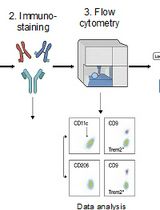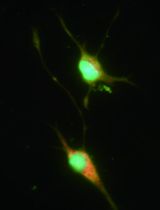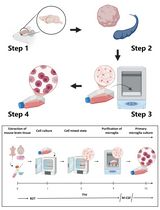- EN - English
- CN - 中文
Efficient Superovulation and Egg Collection from Mice
高效的超排卵和小鼠卵子收集
发布: 2022年06月05日第12卷第11期 DOI: 10.21769/BioProtoc.4439 浏览次数: 3760
评审: Pilar Villacampa AlcubierreWilliam C. W. ChenSrinidhi Rao Sripathy Rao
Abstract
Superovulation is a method used to reduce the number of mice used per experiment by increasing the egg number. Conventionally, superovulation for obtaining mouse eggs involves the use of equine chorionic gonadotropin (eCG) for stimulation and human CG for induction. Female mice of the C57BL/6 inbred strain spontaneously ovulate approximately 10 eggs. The average number of eggs ovulated using the conventional superovulation method is approximately twice as high as that obtained by spontaneous ovulation. Here, we describe the conventional and non-conventional methods of intraperitoneal injection of superovulation reagents in mice and subsequent egg collection. The non-conventional superovulation method combining anti-inhibin serum (AIS) plus eCG for stimulation is more efficient than conventional superovulation. Appropriate intervals from each injection to sampling induce large numbers of high-quality eggs. Immediately after ovulation, eggs are surrounded by cumulus cells, forming an egg-cumulus complex. These cumulus cells are then removed from the egg-cumulus complex by treatment with hyaluronidase to obtain the exact number of eggs. This protocol is suitable for further manipulations such as intracytoplasmic sperm injection and cryopreservation of eggs, as well as for the analyses of responsivity to superovulation reagents in genetically modified mice obtained by genome editing.
Keywords: Mouse (鼠)Background
Superovulation, involving the stimulation of follicle development and induction of ovulation, is used to increase the number of eggs in animals, including mice. Conventionally, superovulation of mice involves the use of equine chorionic gonadotropin (eCG) that has a follicle-stimulating hormone (FSH)-like activity and human CG (hCG) for stimulation and induction, respectively. Anti-inhibin serum (AIS) neutralizes the function of inhibin, regulates FSH secretion, and increases the number of ovulated eggs (Wang et al., 2001). Thus, an efficient superovulation method involving the combined use of AIS with eCG for stimulation, increases the number and improves the quality of ovulated eggs, and reduces the number of mice used in animal experiments compared with the conventional superovulation method (Takeo and Nakagata, 2015). Furthermore, we and other researchers have compared the responsivity of multiple mouse strains to these superovulation reagents (Takeo and Nakagata, 2015; Shindo et al., 2021). Eggs obtained from superovulation reagent-treated female mice are used for subsequent applications such as intracytoplasmic sperm injection (ICSI) and cryopreservation of eggs. Considering that the demand for mouse egg manipulation will continue increasing to produce mouse modelsthat reproduce human diseases and to perform in vivo functional studies using genome editing techniques in the future, as well as the application for in vitro fertilization, we describe an efficient protocol for the superovulation of mice and subsequent egg collection.
Materials and Reagents
Glass pipettes (Drummond Scientific Company, MICROCAPS®, catalog number: 1-000-0500)
1.5 mL microcentrifuge tubes (WATSON, catalog number: 131-815C)
50 mL tubes (Greiner, catalog number: 227261)
10 mL plastic pipettes (FALCON, catalog number: 357551)
1,000 µL pipette tips (WATSON, catalog number: 110-7-6C)
200 µL pipette tips (WATSON, catalog number: 110-705C)
10 µL pipette tips (WATSON, catalog number: 110-207C)
Kimwipes (NIPPON PAPER CRECIA Co., Ltd., catalog number: 62020)
Paper towels (ASKUL, catalog number: 1944368)
35 mm dishes (IWAKI, catalog number: 1000-035)
60 mm dishes (CORNING, catalog number: 351007)
Syringes with needles (Terumo Corporation, 1 mL syringe with 26-gauge 1/2-inch needle, catalog number: SS-01T2613S)
Disposable gloves (AXEL, catalog number: 61-7347-30)
C57BL/6N and C57BL/6J female mice (Japan SLC, Inc.): 4–6 and ≥10 weeks of age (excluding 7–9 weeks of age because they are unsuitable for superovulation)
eCG (ASKA Animal Health Co., Ltd., SEROTROPIN®, 1,000 IU × 10 vials, catalog number: No application), store at 4°C
AIS plus eCG (Kyudo Co., Ltd., CARD HyperOva®, 1 mL, catalog number: F021), store at -20°C
hCG (ASKA Animal Health Co., Ltd., Gonadotropin for animal, 3,000 IU × 5 vials, catalog number: No application), store at 4°C
Saline (Otsuka Pharmaceutical Co., Ltd., 20 mL × 50 vials, catalog number: Not applicable): Store at room temperature
CARD mHTF medium (Kyudo Co., Ltd., 2 mL, catalog number: GA017), store at 4°C
M2 medium (Merck, EmbryoMax® M2 Medium, catalog number: MR-015-D), store at -20°C
Hyaluronidase (Sigma-Aldrich, catalog number: H3506-100MG), store at -20°C
Liquid paraffin (Nacalai Tesque, Inc., Specially prepared reagent, catalog number: 26137-85): Store at room temperature and in the dark, away from sunlight
70% ethanol (Yoshida Pharmaceutical Company, Ecosyoueta disinfectant solution, catalog number: 14987288980046)
Aluminum foil (AXEL, catalog number: 6-713-01)
Equipment
Protective equipment (e.g., masks, goggles, and lab coats)
CO2 incubator (ASTEC Co., Ltd., model: SCA-165DS)
Stereo microscope (Nikon, model: SMZ645)
Dry-heat sterilizer (Panasonic, model: MOV-212S-PJ)
Precision balance (AXEL, model: 1-1726-01)
Ampoule cutter (AXEL, model: 5-124-22)
Alcohol lamp (AXEL, model: 6-487-01)
Pipette controller (FALCON, model: 357469)
P-1000 pipette (GILSON, model: F120602)
P-200 pipette (GILSON, model: F123601)
Micropipette (Eppendorf, model: 4920000024)
Mouth pipette (Drummond, model: 2-040-000)
Filter (Millipore, model: SLGPR33RS)
Ampoule glass cutter (AXEL, model: 5-124-22)
Large straight scissors (Natsume Seisakusho Co., Ltd., model: B-3)
Small straight scissors (Natsume Seisakusho Co., Ltd., model: B-12)
Curved tip tweezers (AXEL, model: 6-531-19)
Tweezers (AXEL, model: 2-529-12)
Precision tweezers (DUMONT, model: NO.5-INOX)
Needle (AXEL, model: 2-013-01)
Dispenser for paraffin liquid (Nichiryo Co., Ltd., model: 00-DP-2B)
Mechanical tally counter (AXEL, model: 63-1584-34)
Plastic cages (Clea Japan, Inc., model: CL-0103-2 Mouse TPX)
Software
Microsoft Excel (Microsoft Corporation)
Procedure
文章信息
版权信息
© 2022 The Authors; exclusive licensee Bio-protocol LLC.
如何引用
Readers should cite both the Bio-protocol article and the original research article where this protocol was used:
- Shindo, M., Miyado, K., Kang, W., Fukami, M. and Miyado, M. (2022). Efficient Superovulation and Egg Collection from Mice. Bio-protocol 12(11): e4439. DOI: 10.21769/BioProtoc.4439.
- Shindo, M., Tsumura, H., Miyado, K., Kang, W., Kawano, N., Yoshida, T., Fukami, M. and Miyado, M. (2021). Similar responsiveness between C57BL/6N and C57BL/6J mouse substrains to superovulation. MicroPubl Biol 2021.
分类
发育生物学 > 繁殖
细胞生物学 > 细胞分离和培养 > 细胞分离
生物科学 > 生物技术
您对这篇实验方法有问题吗?
在此处发布您的问题,我们将邀请本文作者来回答。同时,我们会将您的问题发布到Bio-protocol Exchange,以便寻求社区成员的帮助。
提问指南
+ 问题描述
写下详细的问题描述,包括所有有助于他人回答您问题的信息(例如实验过程、条件和相关图像等)。
Share
Bluesky
X
Copy link












